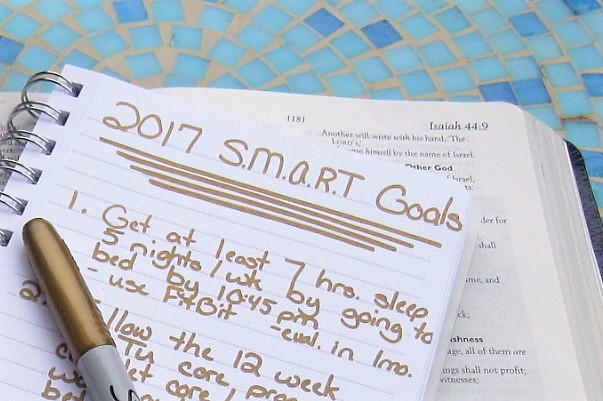Setting goals is the first step in turning the invisible into the visible.
— Tony Robbins
But the second step is making them S.M.A.R.T.
While some may believe that setting New Year’s Resolutions is useless and futile, it is hard to shake off the desire to start something new, fresh and purposeful in the new year. There seems to be this air of enthusiasm, desire and motivation to give more, push harder and go further. The entrance of the New Year motivates many of us to evaluate, plan, set goals and take steps to change what we dislike.
Many people don’t accomplish what they set out to do because goal setting is a bit of a learned art, but there IS a strategic way to go about creating smart and effective goals you can actually achieve. While the initial drive and enthusiasm may seem like the perfect fuel for your ambitious dreams of self improvement, time, busyness and distractions have a way of crumbling what we thought was the perfect plan.
The newness, excitement and motivation wears off and life settles back into a natural, ‘normal’ pace. Thedisciplines we tried to teach ourselves over weeks, maybe even months become boring and even dreaded. We resent what we “should do” and begin to feel chained to rigid rules.
Have you ever found yourself locked into this cycle?
So how do we break free and begin to see progress? How do we set SMART goals that we can actually accomplish? How to we avoid slipping back into old behaviors and truly embrace the positive change? Is there a way to avoid feeling like a failure, again?

Research shows that the one monumental key to accomplishing a goal is to make them S.M.A.R.T.
Specific
Measureable
Attainable
Realistic
Timely
By investing a few extra minutes planning a goal, you can dramatically affect the clarity of the goal and your ability to actually achieve it!
Here are a few examples of some unclear, ineffective goals:
Lose 20 pounds.
Get more sleep.
Get to the gym more often.
Plan out family meals.
Walk during lunch break a few times a week.
Take some time for “me” every day.
While these are some great objectives, the above statements are unclear and do not involve any plan to help an individual change a behavior.
If you have ever struggled with how to create SMART, powerful goals that will get you where you want to go, here are a few questions to walk you through the process.
How clear and specific is my goal?
Lose weight.
Eat smaller portions.
Exercise at the gym more often.
Spend more time with my family.
None of these statements are specific or measurable. Instead, they are quite vague. There is no way to determine whether an individual has or has not accomplished this goal because they do not give enough definitive information about what they are wanting to accomplish.
In order to be specific, you need to identify time (minutes, hours, etc), and/or frequency.
Examples
Eat dinner on a salad size or 8 inch plate for the month of January… -
Exercise for 40 minutes at the gym, 4 times per week for the next 12 weeks…
-
Schedule 1.5 hours every Saturday to grocery shop and meal plan for the week…
-
Begin eating an afternoon snack at 4pm to avoid snacking before dinner every weekday…
Numbers and specifics give clarity as to what you are asking and expecting yourself to do.
Is this a realistic or attainable goal?
This can be a difficult question to answer because often we want to assume we can make HUGE, significant changes without experiencing too much discomfort. The reality is that all change is difficult, and the bigger the mountain, the more difficult the climb. Change often affects family members, housemates, and others around us as well.
For example, your decision to bring your lunch to work instead of eating out with co-workers any longer may cause some disappointment and even resentment among the co-workers.
Begin by setting reasonable goals. Maybe set a very small goal for 1 week and then after you successfully accomplish it, slightly increase the difficulty level each week.
Examples
Long Term Goal
Drink½ body weight in ounces each day (we will pretend this is 80 ounces)
Short Term Mini Goals
Week 1: take a 20 ounce water bottle to work each day (5 days) and drink entirely before coming home.
Week 2: take a 20 ounce water bottle to work each day (5 days) and drink 20 ounces before lunch, refill and then 20 ounces before coming home.
Week 3: continue water bottle routine at work and add in 20 ounces water to evening routine (drink completely between 5-10pm).
Each week the goal slightly intensifies, adding more and more water until the long term goal is reached. Essentially, the individual is building upon the goal, making it attainable and more realistic to achieve each day.
Also important to note, by slowly changing the behavior rather than expecting dramatic change overnight, the individual can figure out how to adapt plans on busy days, when traveling, during meetings, etc. This requires personal problem solving which helps the behaviors stick better long term.
When will you re-evaluate progress?
A goal and plan has little value if one does not assess progress. How often do you want to evaluate yourself on your personal growth in this particular area?
Do you want to set small, weekly goals that you evaluate on a certain day of the week? Do you want to check in 1 time per month on a specific behavior or activity you are adding to your routine?
You don’t know if you are getting anywhere if you don’t periodically take time to step back and evaluate where you are. Sometimes you are further than you think!

How will you evaluate your progress?
There are a variety of methods to evaluate how successful you have been following your goal. Make sure to choose the right method for your goal.
A few ways you can evaluate progress on a health goal:
-
Labs– a physician office may have you return in 3 months to draw new labs and assess
-
Measurements– waist, hips, arms, thighs, etc.
-
Checklist- a great way to check off work outs, meeting daily water goal, hours slept, etc.
-
Strength and Fitness tests– variety of fitness tests often offered at a local gym where they assess strength, endurance, flexibility, etc.
-
Food diary– a clear way to assess whether you chose the types of foods, meals, eating patterns or frequency of meals that followed your goal.
-
Apps– there are dozens of Apps that allow you to monitor or track progress, but the key is updating it consistently
-
Journal– an excellent tool, especially for goals that are focused on changing the way we think about a certain topic and changes in our response to stress, triggers and difficult situations
A word of warning: Stepping on a scale is NOT always a good measure of success. Make sure to evaluate the BEST method for your particular goal.
Who will support you?
Gaining support and accountability is critical to goal achievement. Specifically look for people that are 1 or 2 steps further along and can share, educate, coach, counsel and especially listen, when you are doing well AND when you are struggling.
It is also wise to look for ways to set up natural accountability for yourself. You may want to create a group at work, church or in your community.

Smart goals are not difficult, but they are planned, written, strategic and measurable. If you want to become a more action-oriented, powerful person in 2017, goals can get you there.
Let’s all get SMART and kill it in 2017!
TRUTH: Careful planning puts you ahead in the long run; hurry and scurry puts you further behind.
Proverbs 21:5
